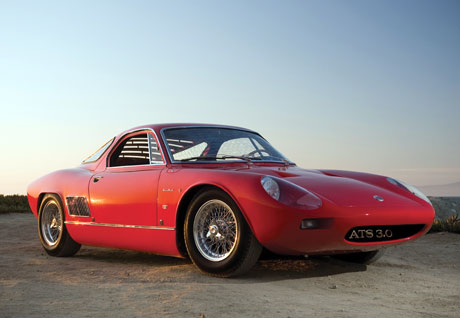SCM Analysis
Detailing
| Vehicle: | 1963 ATS 2500 GT 3.0 |
| Number Produced: | 8 (12 chassis) |
| Original List Price: | n/a |
| Tune Up Cost: | $4,000 |
| Distributor Caps: | $750 |
| Chassis Number Location: | Stamped on passenger side main chassis tube, beneath front bonnet |
| Engine Number Location: | Raised casting on block |
| Club Info: | Vintage Sports Car Club The Old Post Office Chipping Norton Oxfordshire, UK OX75EL |
| Website: | http://www.vscc.co.uk |
| Alternatives: | 1964 Alfa Romeo TZ2; 1967 DeTomaso Vallelunga; 1964 Porsche 904 |
| Investment Grade: | A |
This car sold for $510,017, including buyer’s premium, at RM’s Automobiles of London Auction in England, on October 28, 2009.
Almost simultaneously in 1963, less than 40 kilometers apart on either side of Bologna, two Italian firms embarked on the specific task of beating Enzo Ferrari at his own game. Only one, Lamborghini, lasted more than three years and thrives today in the hands of Audi.
The other, ATS, lost its primary financier, Count Giovanni Volpi, practically before the doors opened and lasted not quite four years. It is clear that Ferruccio Lamborghini’s insistence on a “no racing” policy allowed his company to survive; it is also clear that the ill-begotten Formula One program of ATS sank the firm.
Mid-engine chassis years ahead of Ferrari
Certainly the Franco Scaglione-designed 2500 GT was a lovely-looking car and its sophisticated mid-engine chassis was years ahead of Ferrari. ATS guru Winston Goodfellow, who once assembled all five known survivors for a photo shoot, considers the ATS 2500 GT “.the most sophisticated road car of the early 1960s,” and it is hard to argue with his opinion.
But Carlo Chiti and Bizzarrini designed a high-geared racer for the road rather than a practical GT car, as Lamborghini or Ferrari might have produced. Still, when the 2500 GT launched at the 1963 Geneva show, things must have seemed bright for the new company.
The end result was more than sad, with less than a dozen road cars begun, the last four chassis going to Count Volpi for his Serenissima project. This car was built after the closing of the factory and given to noted race mechanic Alf Francis in lieu of payment, along with a spare 2.5-liter engine. Although it wears a Serenissima badge, it is not one of Volpi’s cars.
Owning a car such as this ATS presents a number of challenges. Vehicles like this are very much the province of a “mature” collector. As one of eight made and with five thought to survive, it’s not a car to be used with abandon, as parts would have to be fabricated in case of any over-exuberance.
It’s impressive that the former owner of this car used the 2008 Modena Cento Ore as its post-restoration break-in. In addition to the 1,000 miles on the rally, the ATS was also driven another 900 miles around Europe before being dismantled for a mechanical check. Since it had only covered 1,900 miles from new when he bought it, the 2008 jaunt effectively doubled the mileage.
It takes a brave, rich, crafty owner
The previous owner also finished the development work the factory never got around to by replacing the transmission with one more suitable for the street. To do this takes someone brave, or very wealthy, or who owns a restoration shop. In this case, the former owner, an avid SCMer, was all three. Hopefully the new owner has at least two of these advantages.
The engine’s closest relative is the 2-liter V8 in the Alfa Romeo Tipo 33, also a Chiti design. The only direct spares to be had might be one of the engines in the Serenissima cars, all of which are still owned by the Volpi family and unlikely to be available. It’s not clear how much this car has in common with the Alfa, and chances are that replacement parts will have to be custom-machined. Usefully, this car came with blueprints for both 2.5- and 3-liter engines.
So if you don’t have a personal machine shop and will not be flogging the ATS in rallies or vintage racing, you’ll show it. It appeared at Pebble Beach in 2009 and came with an invitation to the Concorso Villa d’Este for 2010. Chances are good you’ll be accepted at whichever show you fancy-provided the owner of one of the other four ATS cars hasn’t applied.
Valuing a piece such as an ATS is speculative in the extreme. When one of eight somewhat obscure cars changes hands, each sale makes its own market. RM cannot be faulted for assigning a fairly wide £600,000-£1,000,000 ($900k-$1.65m) estimate, as comparables are difficult to find. The $510,017 realized in the no-reserve sale seems in line with cars such as the Alfa Romeo TZ1 or Lamborghini Miura SV, rather than the TZ2 or Ferrari 400 Superamerica valuation zone of the high estimate.
Perhaps if the Le Mans and Targa Florio entries rumored for this car had been documented, or if it came with a spare 3-liter engine, it may have come closer to the estimates. In any event, the new owner has an unusual part of Italian sports car history. Now he must find ways to use it.
